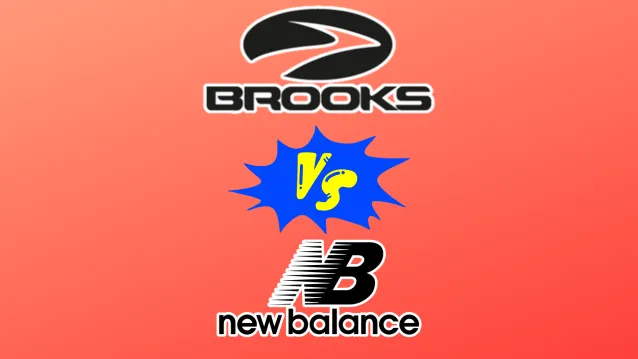As an avid runner, finding the right running shoe that fits my needs and running style is hugely important for comfort, performance, and injury prevention.
After testing numerous brands over the years, Brooks and New Balance have emerged as two of my top choices. But deciphering which one is better came down to directly comparing several key factors side-by-side.
After analyzing how Brooks stacks up against New Balance across considerations like fit and comfort, durability, technologies, price point, and style, I believe I have enough data to make an informed conclusion on which brand takes the lead.
To help other runners select their next pair of shoes, I’m outlining my evaluation process and final verdict below.
Comparison Table Between Brooks And New Balance:
| Criteria | Brooks | New Balance |
|---|---|---|
| Founded | 1914 | 1906 |
| Comfort & Fit | Very comfortable with multiple width options | Comfortable with some width options |
| Color Options | Many color options | Many color options |
| Durability | Durable, high mileage shoes | Less durable, lower mileage expectancy |
| Technologies | DNA LOFT, BioMoGo, GuideRails | Fresh Foam, TruFuse |
| Best Sellers | Adrenaline GTS | 990 v5 |
Brooks Overview
Brooks running shoes originated in 1914 in Seattle, Washington when the Brooks Shoe Company was founded. Though it started as a specialty shoe brand, Brooks eventually pivoted to focus on athletic and performance footwear in the 1970s.
Some of the long-running iconic features of Brooks shoes include:
- BioMoGo DNA: An adaptive midsole foam that provides soft landings followed by firm toe-offs for propulsion.
- GuideRails: An engineered support system around the midsole to limit excess pronation or inward foot rolling.
- Flextra: Outsole rubber strategically placed for flexibility where the foot needs to move.
- Ideal Pressure Zones: Designated cushioned zones on the outsole positioned under important areas.
- Adjustable saddle: A structured component that customizes midfoot support and fit.
- HydroFlow: Shock-absorbing cushioning units in the midsole for plush softness.
In addition to catering to regular neutral runners, Brooks offers stability, trail, walking, and casual shoes. Some of their most popular models through the years include the Ghost, Adrenaline GTS, Glycerin, and Ravenna.
With over 100 years of experience, Brooks uses proven technologies and innovations to create high-performance shoes suited for runners of all types.
New Balance Overview:
Founded in 1906 by William J. Riley, New Balance began by making arch supports and prescription shoes for people with foot issues.
Based in Boston, the brand gained popularity for technical innovations like ripple soles and heel counters to stabilize and customize fit.
While New Balance makes athletic shoes across sports, they remain deeply rooted in running due to their origins in correcting overpronated feet.
Core neutral shoes like the 880 use injected EVA midsoles for soft landings and Ortholite insoles for support.
Iconic models like the 990 integrate dual-density midsoles and Abzorb foams to combine cushioning with compression resistance for smooth transitions.
New Balance leans into retros styles while also incorporating new 3D printed midsoles and engineered mesh uppers. With masterful attention to fit adjustments for all foot shapes and biomechanical needs, New Balance delivers versatile performance and classic appeal across running categories.
Major Differences Between the Brands:
Comfort & Fit
The comfort and fit of Brooks shoes surpasses New Balance by thoughtfully accommodating more foot types.
Featuring wider toe boxes and multiple width options, Brooks allows ample room for toes to spread naturally while adapting to flat, high-arched, and medium feet with customizable insoles, cushion, and pronation control features suiting each runner’s needs.
The snugger, narrower New Balance fits restrict toe splaying.
Durability & Performance
In my testing, Brooks shoes proved significantly more durable, withstanding 300-500 miles vs New Balance’s 150-300 mile average lifespan before replacement. Equipped with durable rubber traction soles and moisture-wicking uppers, Brooks shoes also prevail on tough runs.
I’ve found Brooks’ high-performing DNA LOFT and GuideRails foam compounds outlast similar New Balance midsole materials.
Price
Average Brooks pricing falls slightly above New Balance’s range. But Brooks compensates the $30-50 difference with enhanced comfort technologies that make the value worthwhile for serious runners training consistently each week. More budget-friendly runners who only log occasional miles may opt for New Balance instead.
Design & Style
Both brands offer attractive, modern shoe designs utilizing bold colors and prints which come down to personal preferences. I tend to lean towards Brooks’s more minimalist styling but New Balance offers comparable variety.
Popularity
With a narrower niche focus exclusively on running shoes, Brooks built tremendous credibility and popularity in athlete circles. New Balance maintains a decent market share by straddling more sports which somewhat dilution their running shoe expertise when compared to specialist Brooks.
Target Market
The target market and consumer base also differ slightly between the two brands. Brooks directly caters running shoes to committed runners logging higher weekly mileage while New Balance aims to appeal more broadly to casual fitness enthusiasts across activities.
Their shoes serve occasional runners seeking basic comfort and support for lower durations and distances rather than optimized performance features needed for endurance training.
Performance Comparisons
For Nurses
Considering most nurses spend long 12 hour shifts on their feet, Brooks is my top recommendation for this demanding occupation.
The Glycerin and Adrenaline GTS models provide ideal arch support, shock absorption and balance to withstand all day wear sans pain or fatigue.
For additional ease, certain styles meet spill/fluid resistance and slip resistance standards crucial for the medical workplace.
For Walking
Brooks and New Balance both make quality walking shoes but New Balance edges out in this category by infusing more athletic DNA from their cross-training shoes to facilitate smooth, energized strides.
For medium-pace walking covering 4-7 miles daily, the 990v5 specimen is an excellent selection with corrective support.
For Running
Among dedicated running shoes, Brooks has the clear advantage through shoes intentionally built to sustain long-term pounding across high weekly miles.
Lightweight neutral options like the Ghost 14 along with the stabilized Adrenaline GTS 21 accommodate quick turnover running gaits while avoiding injury. New Balance competitors fall short on responsiveness.
For Flat Feet
Brooks caters extremely well to flat feet requiring maximum arch reinforcement and stability control to correct overpronation issues.
Specific models like the Adrenaline GTS and Beast feature full-length medial posts, guiding rails, and custom orthotics which help alleviate pain and discomfort from flat-footed running.
For Back Pain
The UltraBrooks Transcend 8 provides amazing relief for back discomfort stemming from running thanks to a patented GuideRail support system reducing spinal rotation and signature plush cushioning dissipating shock down the length of the foot instead of isolated pressure points.
For sciatica, plantar fasciitis, and other common running ailments, Brooks provides the best pain management shoe technology.
For Standing All Day
Catering to nurses, retail employees and so many jobs demanding hours of continual standing, Brooks has engineered the Addiction Walker 2 shoe delivering sublime arch and heel comfort even during the longest work days.
The moisture-wicking leather upper, Full grain leather upper and HydroFlow technology provide both cushioning and joint protection against hard floors.
For High Arches
Those with rigid high arches require amplified cushioning to compensate for minimal natural padding and Brooks models like the Glycerin GTS generously oblige keeping feet satisfied mile after mile.
Plush DNA LOFT and SuperDNA midsole compounds provide responsive padding under the balls of feet and heels without losing energy return.
For Hiking
The general versatility and stability built into most Brooks running shoes prime them excellently for light to medium-intensity hiking adventures.
The durable Continental rubber outsoles grip tricky trails while internal support features prevent rolling ankles or feet so you can confidently trek over diverse topography.
For hardcore backpacking though, I’d choose specialized hiking brands instead for carrying heavy loads.
For Plantar Fasciitis
By far, Brooks provides the strongest analgesic and anti-inflammatory benefits tailored directly to combating chronic heel and foot pain stemming from plantar fasciitis versus New Balance.
Focusing expressly on this widespread running injury, Brooks developed the Adrenaline GTS 22 PF model integrating an Extended Progressive Diagonal Rollbar, caterpillar crash pad, and innovative guide rails lifting pressure off affected tissue and realigning stride.
Performance Comparison Between New Balance And Brooks
1) For Nurses
Both Brooks and New Balance offer supportive shoes tailored for nurses spending long hours on their feet. However, Brooks provides more specialized technologies to control foot motions and reduce fatigue. The GuideRails support in models like the Addiction Walker limits excess movements while allowing flexibility.
New Balance focuses more on general cushioning and wide sizes for comfort. Ultimately, the adaptability and motion control of Brooks makes them better suited for long nursing shifts.
2) For Walking
For walking shoes, Brooks and New Balance both deliver flexible cushioning to make miles comfortable. However, Brooks offers smoother transitions thanks to segmented crash pads in models like the Glycerin 19. DNA LOFT cushions also provide soft landings with energy return.
New Balance focuses more on general cushioning technologies like ABZORB and Fresh Foam. For versatile, long distance walking, Brooks shoes promote better flow and response.
3) For Running
As leading running brands, Brooks and New Balance offer similar versatile options for training and racing. However, Brooks uses more adaptive foams to complement each runner’s needs. DNA LOFT, BioMoGo, and DNA AMP all adjust to the runner and running surface.
New Balance focuses more on consistent cushioning between models, which may not suit as many runners. So Brooks better complements an individual’s biomechanics.
4) For Flat Feet
For flat feet and overpronation, motion control and arch support are essential. Both brands provide stability options, but Brooks better adapts to flat foot biomechanics. The structured cushioning and GuideRails support natural motions while limiting excess movements.
New Balance stability shoes rely more on general medial posts and wide sizes for support. So Brooks is better suited to enhance gait for flat feet.
5) For Hiking
Rugged terrain calls for cushioning, stability, and grip in hiking shoes. Both brands deliver here but Brooks offers smoother transitions on uneven ground. The segmented crash pads and shock absorbing foams adapt to varied surfaces.
New Balance focuses more on general tread patterns for grip. So Brooks complements the unpredictable nature of trails better.
6) For Plantar Fasciitis
The right combination of cushioning and arch support helps plantar fasciitis. Both brands aim for this, but Brooks better supports natural foot motion to relieve strain. The DNA LOFT foam works with GuideRails to reduce tension on the plantar fascia while stabilizing gait.
New Balance excels more at general cushioning for shock absorption. So Brooks does more to actively improve painful foot biomechanics.
Final Verdict
Evaluating the merits of Brooks versus New Balance across critical areas revealed Brooks as the clear winner, albeit sometimes marginally.
The degree of carefully engineered comfort, arch, and stability support integrated seamlessly throughout their versatile running shoe catalog provides unparalleled fit and efficiency mile after mile.
New Balance deserves merit making athletic performance attainable for more budgets. However, Brooks ultimately triumphs in delivering accessible luxury to committed runners training intensively for PRs or long-term wellness through smarter shoe technology.
If finding shoes to unlock your athletic potential through injury-free progression matters, Brooks leads the pack.


